
The Slivers
By Patrick Janssen 'zip104'
Last updated 22 August 2006
The Slivers was a Belgian Air Force aerobatic team
consisting of a pair of F-104G Starfighters. Formed in 1969, they were the first team in
the world to perform aerobatics as a team with the F-104. When they closed down in 1975
they had performed a total of 79 shows without a single accident.

The flightgear
Based upon available photographic evidence, the Slivers used mainly two types of
helmets during their period as a team. Steve always had a HGU-2A/P dual visor single piece
ramshorn, but Palmer used also a single visor HGU helmet for some time, before switching
to the dual ramshorn. Steve managed to drop his helmet at some point in time which led to
its replacement by another ramshorn. Their helmets were equipped with white styrene inner
liners and brown pads and spring retention arms for the headphones (H154/AIC headset). The
communication leads were standard for the period of time, as well as the MBU-5/P masks
with "T" bayonets fitted in cast receivers.
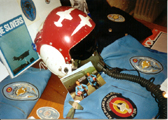
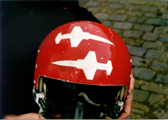
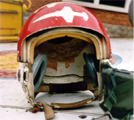
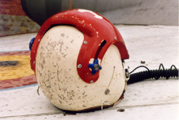
HGU-2A/P one-piece ramshorn helmet with the striking Slivers
artwork. This helmet was used by Steve Nuyts and is
now displayed at the Beauvechain Air Base museum in Belgium. Pictures © Patrick Janssen.
Initially the helmets were in standard
Belgian AF 350 Squadron colours (with distinctive personal touches for each pilot), but
after a while they painted the visors of their helmets in red with two white crossing F-104 silhouettes. If it was on purpose or not
cannot be ascertained, but the two F-104’s were exactly on scale 1/72nd!
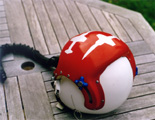
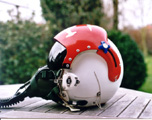
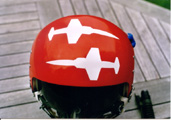

Replica Slivers helmet made by the author. Patrick had the
advantage of being able to study Steve Nuyts' helmet in
detail before he undertook this work. The picture on the far right shows Patrick's helmet
together with a replica period
helmet bag with Slivers artwork. Pictures © Patrick Janssen.
The flight suits were originally the standard orange or olive green with 350 Squadron patches, but as of the season 1972 they got their light blue coloured ones with their names embossed upon a round F-104 patch on the left-hand side and a specially created Slivers patch on the right-hand side. The flight suits and one of the helmets – the one from Steve – are on public view in the Beauvechain AB museum. The pictures shown of Steve’s helmet and the flight suits were taken at this location.
How the team was born
In 1966 Major Bill Ongena, who was the official demonstration F-104 pilot of the
Belgian AF and incidentally also one of the original members of the Acrobobs aerobatic
team (precursor of the Red Devils team) flying Meteor F.8, was promoted to a new function
in the national defence office. He was succeeded by Captain
François "Susse" Jacobs, who had been part of the Red Devils demo team while
they flew the Hawker Hunter. Unfortunately Susse lost his life soon after taking up the
assignment. On the 2 September 1968, during the taking of an episode of the French
television series "Les Chevaliers du Ciel" something went wrong during a
"touch-roll-touch-and-go" manoeuvre and Susse was killed in spite of a
last-minute ejection.
After this crash the General Staff of the Belgian AF banned all demos on the F-104. Only
after lengthy discussions with the concerned authorities and a lot of personal efforts by
Colonel Paul De Wulf, CO of Beauvechain AB and another of the original members of the
Acrobobs aerobatic team, permission was granted to re-start the demo flying with the
Starfighter.
In the beginning the idea was to have a team with one pilot of each Beauvechain Squadron
(349/350), but this proved impractical from a viewpoint of availability for training.
Major Steve Nuyts volunteered from the beginning for the team and could finally convince
Warrant-Officer Palmer De Vlieger to become the second member of the Slivers. After a lot
of training the Slivers made their first public appearance on the 14th of May 1969 as
"special guests" for a graduation ceremony at Brustem AB.
The genesis of the name
"Slivers"
The famous Lockheed test pilot Glenn "Snake" Reaves called the F-104
prototype the "Silver Sliver" because of the long shiny fuselage and stubby
wings of the Starfighter. This name stuck also with the forthcoming Belgian demo pilots
and so they decided to use "Slivers" as the name for the team.
The show
The Slivers were the first team in the world to perform aerobatics as a team with the
F-104. Close to the ground and at speeds in the region of 400 knots IAS (approx. 800 km/h)
the two pilots moved their aircraft with such ability and self control that they succeeded
in crossing each other exactly on a well determined point and this in complete
synchronisation. Also, despite the high "G" forces due to the high speed
manoeuvring and the poor turning performance of the Starfighter, the pilots were
successful in keeping their display close to the spectators. The separation between the
two planes during their crossings varied between 10 meters and 2 meters… with one
pilot flying above the runway and one above the grass next to it. The respective positions
were announced by radio: "left concrete" and "left grass".
In all, the Slivers flew 79 breathtaking
but completely accident free flying displays during 7 seasons, and this in the United
Kingdom, France, Germany, Italy and of course Belgium. The first show took place on the
14th of May 1969 and the last one on the 11th of July 1975. The team was disbanded when
Steve Nuyts was promoted and nobody was found to replace him as leader of the Slivers.
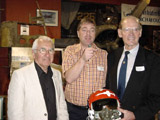
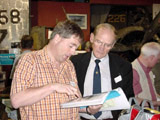
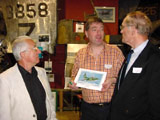
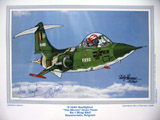
On 10 June 2006 the two Slivers pilots, Steve Nuyts and
Palmer de Vlieger, gave a presentation about the team at
the Belgian Aviation Historical Association. The presentation included some very
interesting video footage taken by
Steve Nuyts from the cockpit.
Far left: Seen from left Palmer De Vlieger, the author, and Steve Nuyts,
the latter holding the author's HGU-2A/P
Slivers replica helmet.
Centre left: The author shows his draft web article to Steve Nuyts.
Centre right: The author shows his special Slivers cartoon made by the
Belgian aviation artist Willy Peeters to Pal-
mer De Vlieger and Steve Nuyts who were kind enough to autograph it.
Far right: A close-up of the Slivers cartoon made by Willy Peeters.
All pictures are thumbnails. Pictures © Patrick Janssen. Drawing © Willy Peeters
The Team
Steve Nuyts was born in 1937 and got his wings in 1957. He flew the following types
during his active career : Meteor, Hunter, Fouga Magister, T-33, F-104 and F-16 and
amassed a total of 5.045 flying hours of which 1.403 hours on the Starfighter. He made his
last active flight in a Fouga on the 23rd of December 1983 but continued flying as reserve
pilot, making his final flight (again in a Fouga) on the 13th of December 1994. He retired
as a full Colonel.
Palmer De Vlieger was born in 1931 and graduated as a pilot in 1954. He too flew a lot of different aircraft types in the Belgian AF and clocked a total of 4.459 flying hours, of which almost 2.203 hours in the F-104. Palmer was one of the first Belgian pilots to fly the One-O-Four and flew his last mission also in the Lockheed plane on the 22nd of December 1976. After his BAF years Palmer made a new career in the brewery business.
Warrant-Officer Raymond Delestinne was the dedicated crew chief of the Slivers during their flying period. Thanks to his technical knowledge and expertise not one show had to be cancelled because of technical problems. Raymond is now the driving force behind the Beauvechain AB museum, where he is in charge of the planes kept or being restored there. In this museum some Slivers artefacts are exposed, including Steve’s helmet and his and Palmer’s flight suit.
The planes
During their existence as a team the Slivers flew almost half of all the F-104
Starfighters in service with the Belgian AF. The planes were in standard Vietnam
camouflage and flew always with the Sidewinder launch rails for additional stability in
the turns. In the beginning the rails were white as on all the other Belgian One-O-Fours,
but after a while the team wanted to be a bit "different", so the rails were
painted red with white "Slivers" lettering in the middle of the rail.
In addition to the rails, the Slivers also decided after some time that a more visual clue was necessary to distinguish their planes from the other Starfighters. For the national show on Sunday the 20th of June 1971 In Brustem they put a red ball on the intakes of the FX-68 and FX-51 with the silhouettes of two crossing Starfighters superimposed in white, similar as what they had on their helmets by that time. This scheme was only used for that show, because the red paint did not survive the high speed passes at low level… The white paint faired better, so it was agreed upon to paint the name "SLIVERS" in white on the intakes as of 1971 until the team was disbanded.
Of the planes they flew, Steve had a distinct liking for the FX-90 and Palmer for the FX-72. They also flew these numbers on their last show at their home base in 1975 before a limited audience.
Patrick Janssen
zip104
With thanks to Steen Hartov and Peter Gordts for their assistance in creating this script.